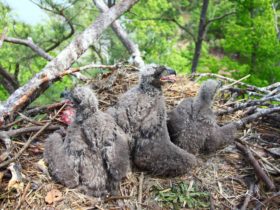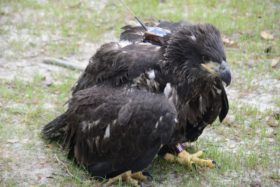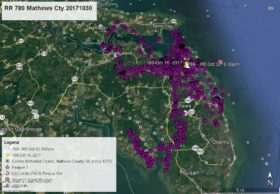Satellite map July 14-19
Satellite map July 11-16
July 16, 2009Satellite Map July 17-22
July 22, 2009
Categories
Hi all – Reese is out of town this week so I’ll be posting maps in his absence.
Over the weekend, Azalea continued to utilize two main areas in her natal territory. She visited the “dump”, or compost and garden refuse area at the Norfolk Botanical Gardens, each day spending most of the morning there before getting up ino a soar over the airport runways.

At night, she returns to roost in the pine trees surrounding her nest (see additional zoomed in map).

Note: map images appear on our posts as thumbnails. Click once to enlarge the thumbnail. Click on the image again to zoom in on the map.
– Libby




11 Comments
Thank you so much for keeping us updated on Azalea. Love knowing where she is and all is going well so far. I hope her brother and sister are okay too. I am wondering if the parents are still feeding or do the juvies have to hunt for their food now.
Yes, thank you Libby. I have been wondering about “our three” feeding themselves, as well. Do the red circles which are located over the water (map) mean that Azalea perhaps pauses there to fish, or are they just a point of change in her flight direction? And about the circles over the airport runways…is she landing or, again, just changing direction? I am concerned about her “hangin’ out” there!
The red circles indicate her location each hour on the hour. The orange lines just connect the dots to give us a general sense of which direction she flew. We assume any point over water is during flight.
Reese or other NBG visitors might be able to tell us more about the feeding habits of the adults and their 3 young fledglings. The adults typically continue to bring food to the young for anywhere from weeks to months after fledging the nest. It’s important for the chicks to learn to forage for themselves at this age. They’ll rely on their parents to show them how to catch fish and other prey.
Has anyone observed any of the three hunting on their own? Have they been successful? Azalea seems to spend a considerable amount of time in or around the nest. Is she doing OK – when she’s squacking is she calling for food?
I NOTICE TO DAY EAGLE IN THE NEST HAS A DARK AREA ON IT’S BEAK I AM VERY CONCERNED IT MIGHT BE WHAT THE LAST YEARS BABY HAS . PLEASE CHECK AND RESPOND THANK YOU
Thank you again, Libby. I now have a better understanding of what the map shows us. You are very articulate, and I have also enjoyed watching you with the eaglets this year.
Susan, thanks for asking your question– for all of us who cannot be there to see them personally!
In response to the comment above about the eagle beak, all three eagles were examined during the last nest visit. None displayed signs of avian pox and all three appeared healthy. That being said, I haven’t seen a close up photo of any of the chicks recently to be 100% certain. Avian pox affects birds the hardest when they have compromised immune systems. The 3 NBG chicks were healthy during the last examination and have all been observed eating and flying normally.
Thank you Libby The eaglet was resting and napping in the nest around 4pm Monday. It may be the youngest because I noticed frequent calling for food. I agree all three seem healthy. Mom and Dad took very good care of them.
Just catching up with the “kids”. Glad all is well, though a tad concerned about “Azalea” buzzing ORF’s runways !
Thank you Team NBG and CCB for all your wonderful information. And to my friends in the eagle chat room, c’ya’s next year !
I’m recommending Nuchols Tree Service to all my friends and neighbors !
Hello Libby The eaglet is in the nest again it is 8:10 pm and is calling alot. The right side of the beak is a lot darker than the left side . It’ not Azalea I think it’s the youngest eaglet. The feathers look a little scruffy but it” getting dark…hard to see. Has anyone else noticed this?
Azalea is in the nest eating lunch(1:35pm) and cleaning her beak. When will their beaks change from dark to the color of the adults ? How beautiful she is. What a treat to see them close up. Could not tell what lunch was. It was not fish.